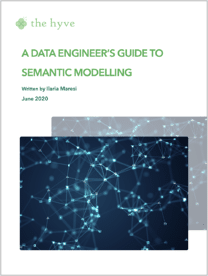 While on her semantic modelling journey and as a Data Engineer herself, Ilaria Maresi encountered a range of challenges. There was not one definite source where she could quickly look things up, many of the resources were extremely technical and geared towards a more experienced audience while others were too wishy-washy. Therefore, she decided to compose this 50-page document where she explains semantic modelling and her most important lessons-learned – all in an engaging and down-to-earth writing style.
While on her semantic modelling journey and as a Data Engineer herself, Ilaria Maresi encountered a range of challenges. There was not one definite source where she could quickly look things up, many of the resources were extremely technical and geared towards a more experienced audience while others were too wishy-washy. Therefore, she decided to compose this 50-page document where she explains semantic modelling and her most important lessons-learned – all in an engaging and down-to-earth writing style.
She starts off with the basics: what is a semantic model and why should you consider building one? Obviously, this is best explained by using a famous rock band as an example. In this way, you learn to draw the basic elements of a semantic model and some fun facts about Led Zeppelin at the same time!
For your model to actually work, it is essential that machines can also understand these fun facts. This might sound challenging if you are not a computer scientist but this guide will walk you through it step-by-step – it even has pictures of baby animals! You will learn how to structure your model in Resource Description Framework (RDF) and give it meaning with the vocabulary extension that wins the prize for cutest acronym: Web Ontology Language (OWL).
All other important aspects of semantic modelling will be discussed. For example, how to make sure we all talk about the same Led Zeppelin by using Uniform Resource Identifiers (URIs). Moreover, you are not the first one thinking and learning about knowledge representation: many domain experts have spent serious time and effort in defining the major concepts of their field, called ontologies. To prevent you from re-inventing the wheel, we list the most important resources and explain their origin.
Are you a Data Engineer that has just started with semantic modelling? Want to refresh your memory? Maybe you have no experience with semantic modelling yet but feel it might come in handy? Well, this guide is for you!
Click here to access a data engineer’s guide to semantic modelling
Written by Tess Korthout

